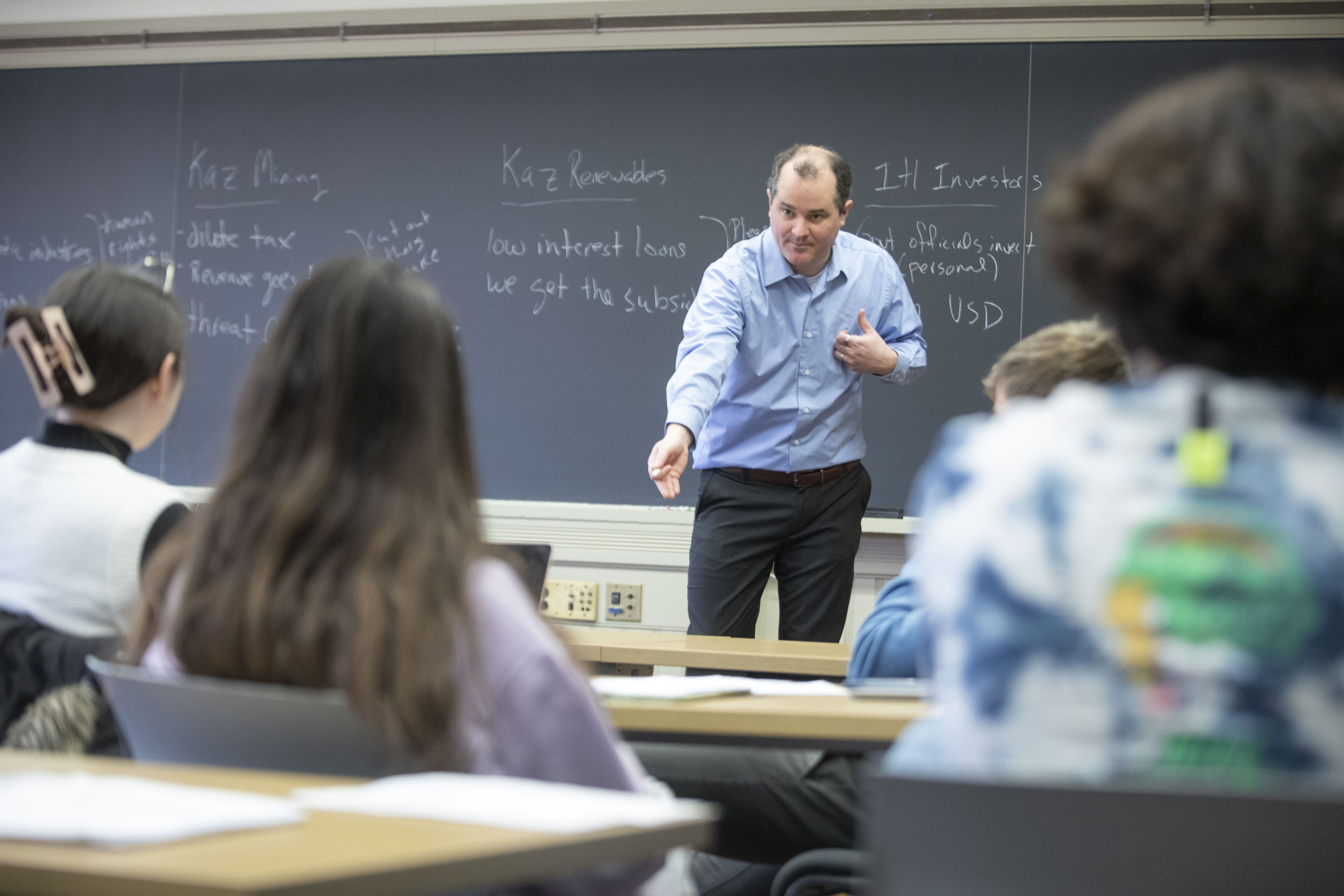
Dustin Tingley (pictured) and Stephen Ansolabehere collaborated with students to design the course “Politics of the Environment and Climate Change.” “They told us they really wanted activity and engagement … something that was practical and outward-looking,” said Tingley.
Photos by Kris Snibbe/Harvard Staff Photographer
How to make effective climate policy — and policymakers
Innovative class builds skills for conceiving, evaluating ideas, turning them into real-world solutions
Imagine the government has imposed a $50-per-month tax on fossil fuels. Should that money be banked, gathering interest for future investment in climate adaptation? Or should it be spent immediately in developing countries hit hardest by climate change?
The matter came up for debate this month in the government class “Politics of the Environment and Climate Change.” One hand shot up immediately with a vote for spending the money later, since compounded interest adds to financial impact. Another student, more tentative, took the position of spending now, to benefit the greatest number of people — both existing humans and those still to be born.
Beaming at the front of the classroom was Dustin Tingley, professor of government, deputy vice provost for advances in learning. “Good!” he cried, rewarding every response with a grin. Climate change is a minefield of competing priorities and interests. But when it comes to finding policy solutions, Tingley later said, the goal is “wrestling with the fact that different groups, all with good intentions, can do things that subsequently lead to tension.”
Launched last spring, GOV1722 contends with climate change as a fundamentally political problem, challenging students to navigate obstacles and opportunities for effective policymaking at all levels of government. “This has always been a gap in the curriculum,” offered Stephen Ansolabehere, the Frank G. Thompson Professor of Government, who teaches the class alongside Tingley. “But it was difficult to know what to do, because it’s a topic that spans so many fields within our discipline — domestic politics, comparative politics, international politics.”
A recent lecture outlined the “normative frameworks” that different negotiating parties may apply to the issue, including utilitarianism and spiritual beliefs about caring for divine creation. Everyone from philosopher John Rawls to economist (and former Harvard University president) Larry Summers was mentioned. Future lessons include the politics of mitigation and adaptation.
The course is supported by Harvard University Center for the Environment, with networking help from the Salata Institute for Climate and Sustainability community. But students were Tingley and Ansolabehere’s closest collaborators in designing the course in fall 2021. “They told us they really wanted activity and engagement,” Tingley recalled. “They wanted something that was practical and outward-looking.” As a result, lectures tend to be highly interactive, requiring students to engage with in-class simulations and polls (such as the $50 fossil fuel tax).
“The assignment structure is atypical compared to other government classes,” observed Pranav S. Moudgalya ’26, who described working on a policy memo about the Colorado River water crisis. As a capstone project, the whole class tackles real-world issues facing surrounding communities. The inaugural GOV1722 section last spring designed a climate plan for Boston, which was circulated around City Hall.
This semester students will break into groups to study the needs of climate-vulnerable cities in the area including Lawrence, Chelsea, and Fall River. They will then write grants to fund initiatives such as flood mitigation and building up renewable energy infrastructure.
“We’re teaching ideas and theories, but really pushing students to apply those things,” said Tingley, who also co-chaired the recent “Future of Climate Education at Harvard University” report.
Student input shaped the course in other meaningful ways. For one, Ansolabehere’s big lecture on environmental justice, originally slated for late in the term, was pushed near the start. That meant something to Kiersten Hash ’25, a government concentrator (with a secondary in environmental science and public policy) who expressed general frustration with the lack of diverse perspectives among Harvard’s climate educators. “I’m pleased with the work our professors are doing in this course,” Hash said. “From the jump, they talked about the fact that the impacts of climate change will be disproportionately felt by the most vulnerable.”
There’s something more students appreciate about the class, which is also available online via Harvard Extension School. As Hash put it: “The general ethos is that we have the potential to solve these problems through critical decision-making and strategic political action.”
Tingley and Ansolabehere can tick off a host of inspiring accomplishments on climate and environmental cleanup: turning around ozone depletion in the 1980s, the leadership of red states Iowa and Texas on wind infrastructure.
“The world has made progress in certain respects,” Tingley said, “just not enough on carbon or greenhouse gases.”
Not yet anyway. This class, and the students who take it, have hope.
Podcast “What Is Holding Up the Transition to Green Energy?” with Dustin Tingley, Jeff Colgan, and Aleksandra Conevska, Weatherhead Center for International Affairs.




